The content industry has witnessed a massive spike with the advent of ChatGPT. Bloggers and content creators have been employing ChatGPT for AI writing, which includes blog posts, emails, sales letters, and more!
However, a major part of blogging revolves around SEO. Though it’s a tricky task, if done right, it may boost your website rankings off the chart! Do you know you can use ChatGPT for optimizing your blog posts?
How, you ask? This article reveals exactly that.
In this article, we will discover the 7 ChatGPT SEO Strategies for 2024. Whether you’re a blogger, content writer, or SEO professional, this article will educate you on using ChatGPT for saving time on SEO optimization.
So, are you ready to discover some exciting ways to use ChatGPT for SEO? Let’s jump right in to find out.
Disclaimer : I strongly believe in transparency. If you buy using the links on our site, we may earn a small commission without any extra cost to you. This helps me to keep producing honest reviews. Read More >>
What is ChatGPT?
ChatGPT is the latest language prediction model developed by OpenAI Labs in 2022. It is based on GPT 3.5 and has been trained on massive amounts of data.

Along with 175 billion parameters, it is also trained on large amounts of human conversations and coding scripts. This makes it function as an advanced chatbot with conversational abilities and professional coding skills.
Since its launch, ChatGPT has been used in a variety of fields. These include AI Writing, blogging, SEO, idea generation, conversations, coding, debugging, etc.
If you wish to know more about ChatGPT, you can check out our blog on ChatGPT Explained, where we have covered everything about this latest language prediction model!
7 Best Ways to Use ChatGPT for SEO
Wondering how you can use ChatGPT to improve your SEO efforts? The field of SEO is vast, and you can optimize every aspect of your blog with ChatGPT.
After much research and testing, I came up with the 7 Best Ways to use ChatGPT for SEO. So, let’s look at them one by one.
1. Keyword Research
Keyword research is one of the most important aspects of SEO. With ChatGPT, you can essentially find categories and subcategories you can build your content around.
ChatGPT appears to be the best tool if you want to build a topical authority. Let’s understand how you can do that.
Topical Authority
The first thing you need to do is enter the following prompt into ChatGPT and specify the profession, category, and number of topics you need it to generate.
Prompt: Act as a [enter profession]. Give me [X] semantically relevant, but unique topics under the main category of [enter category].
Example: Act as a professional digital marketer. Give me 10 semantically relevant, but unique topics under the main category of “social media marketing”.

If the topics are too lengthy, you can enter the following prompt to shorten the keyword length.
Prompt: Reduce each down to 3-5 length keywords
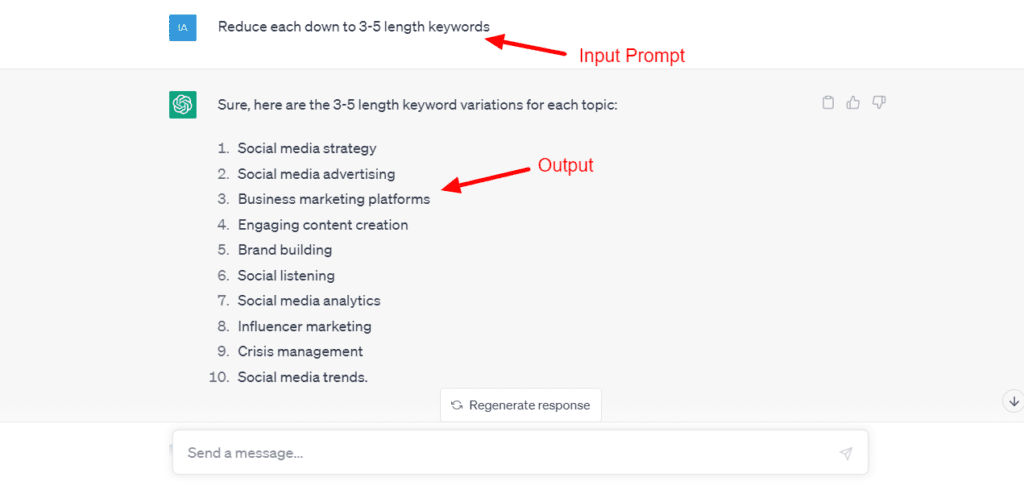
This will reduce the length of the keywords. Once it generates a list of relevant topics, we will supply it with another prompt for generating keyword variations for every prompt. Here’s the prompt you need to enter.
Prompt: Give me [X] different keyword variations of [enter a topic of choice from step 1] that address a different search intent.
Example: Give me 10 different keyword variations of “Brand building” that address a different search intent.
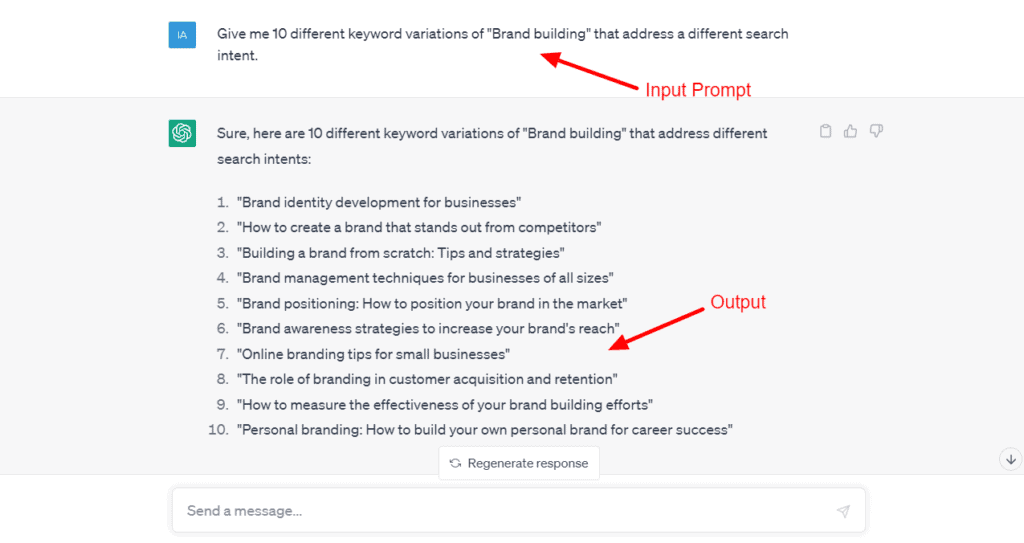
Once you perform the same exercise for all the topics from Step 1, you will have a database of 100 highly relevant topical keywords that you can build your content around. Isn’t that cool?
If you need a tutorial on topical authority building using ChatGPT, you can also check out this insightful video by Matt Diggity.
2. Using ChatGPT SEO Plugin
Next, we have the AIPRM SEO plugin that can be downloaded as a Chrome extension. It integrates with ChatGPT and provides templates for various categories like SEO, copywriting, content marketing, SaaS, productivity, and more.
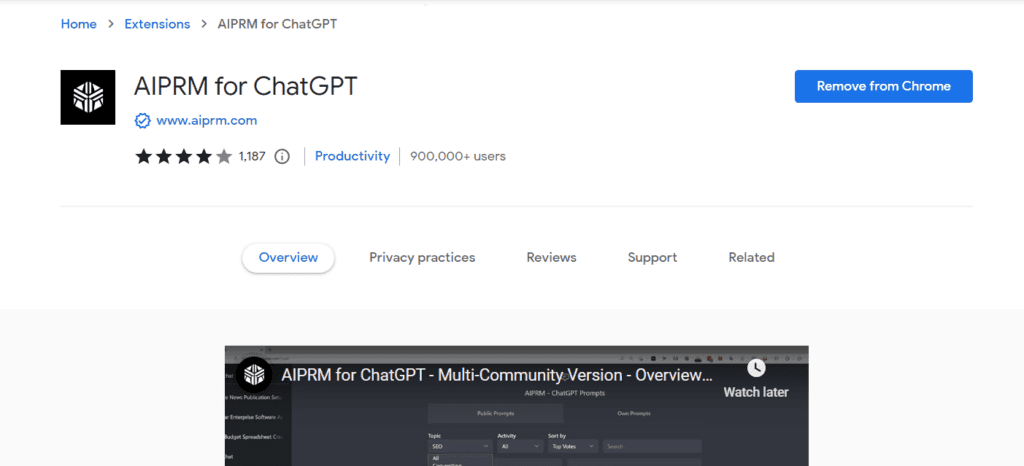
You simply need to select a prompt and enter the details. It’ll automatically run the prompt in ChatGPT and generate relevant outputs.
The best part about using this plugin is that you don’t need to write any queries by yourself. Everything is taken care of by AIPRM prompts! Let’s look at its important use cases below.
Creating a SILO Structure
A SILO structure is simply a way of organizing your website content in a logical manner. Once you select the SILO structure prompt, you simply need to select the language, tone, and writing style, and specify your topic.
For instance, this was the output when I provided the topic “Digital Marketing” and selected the default tone with the default writing style.
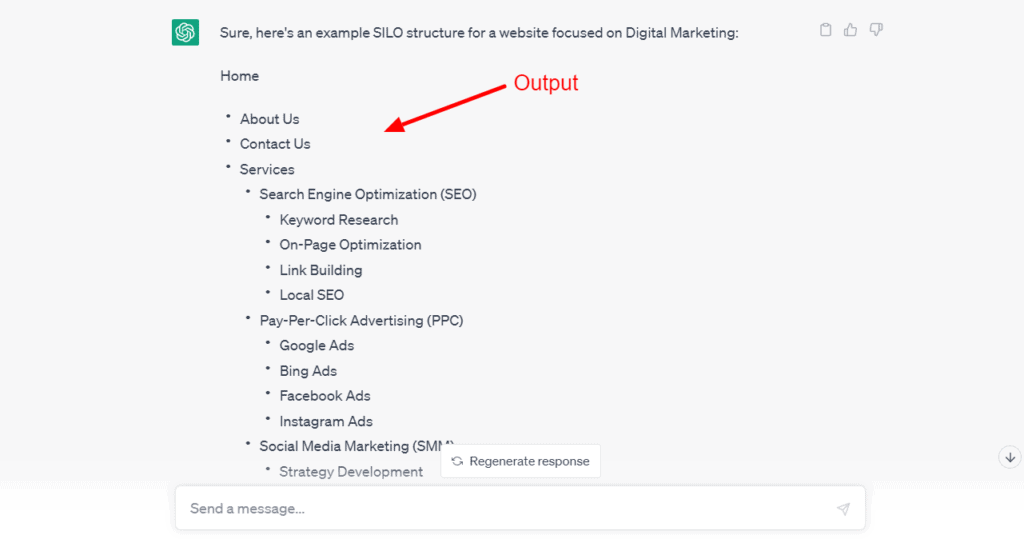
It designed a clear and concise layout for the home page, including different pages to include along with services.
This is helpful when you want to logically organize different content on your website. This makes it easier for search engines to crawl your website, thus boosting SEO rankings.
Keyword Strategy
Next, we can also generate a logical keyword strategy for our website content. You simply need to select the Keyword Strategy prompt and enter your topic.
It will generate keyword clusters along with keywords associated with it, search intent, post title, and meta description. All of this information is displayed in a clean and organized tabular format.
For instance, these were the results when I supplied the topic “Social Media Marketing”.
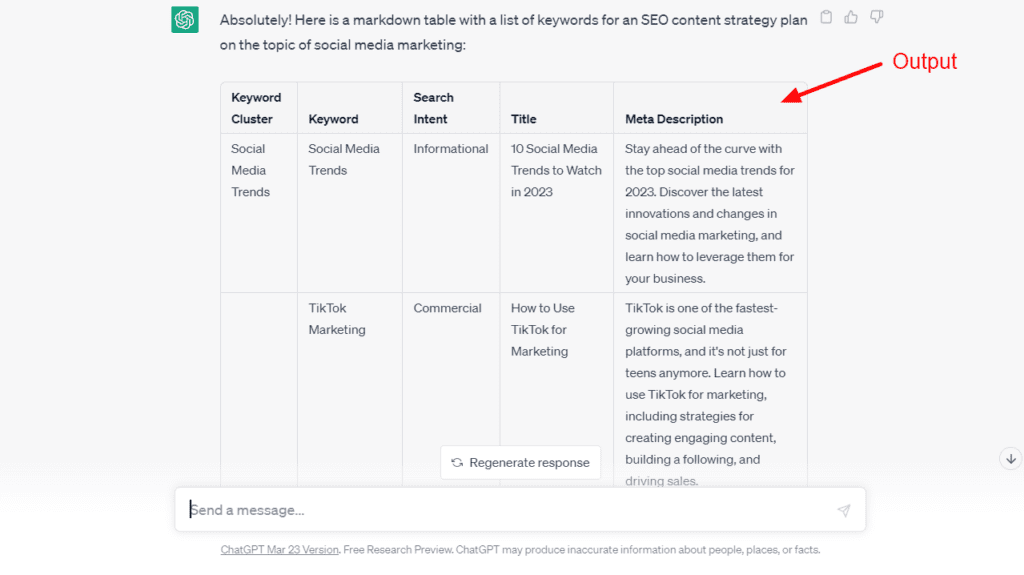
I really like to use this tool for brainstorming keywords and blog ideas. You can use it to devise a solid keyword strategy before starting out with your blog!
Keyword Generator
This is a simple yet powerful tool for generating SEO keywords for any topic. All you need to do is supply it with a topic and it’ll return a list of relevant keywords that you can include in your blog.
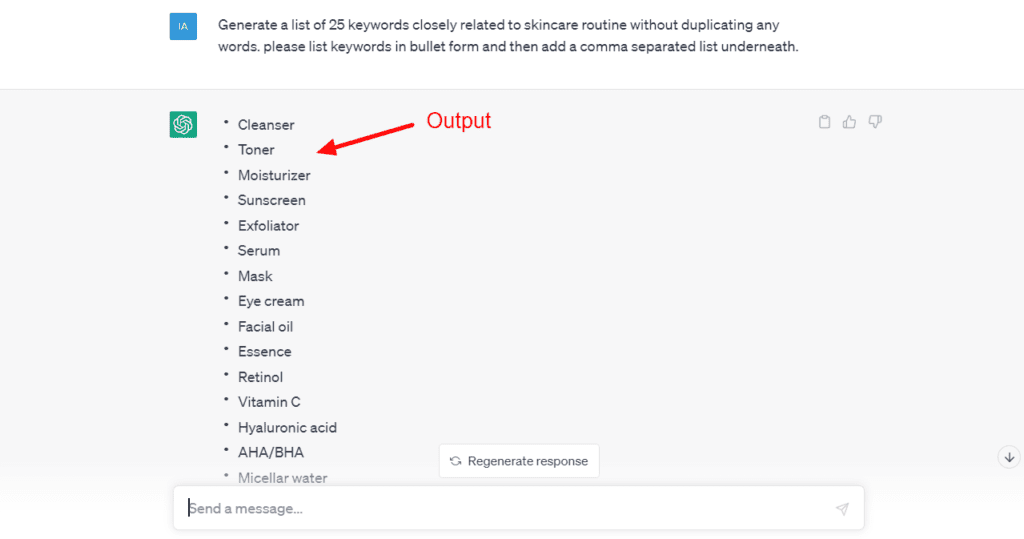
For instance, it generated the above keywords when I entered the topic “skincare routine”. All the keywords were highly relevant and focused.
3. Creating Article Outlines
Another major factor that affects your search engine optimization is the structure of your blog posts. If the outline is structured well, your posts perform better and rank higher on SERP.
I personally like to use ChatGPT to create outlines for my blog posts. Let’s quickly dive in to understand how you can generate in-depth outlines for your blog posts using ChatGPT.
Prompt: As an experienced copywriter, generate a comprehensive, SEO-optimized blog post outline for the keyword [X], targeting an [X] audience with a friendly and helpful tone and the desired length of 3000 – 4000 words.
Example: As an experienced copywriter, generate a comprehensive, SEO-optimized blog post outline for the keyword [Types of Coffee Beans], targeting a [Coffee Drinker] audience with a friendly and helpful tone and desired length of 3000 – 4000 words.
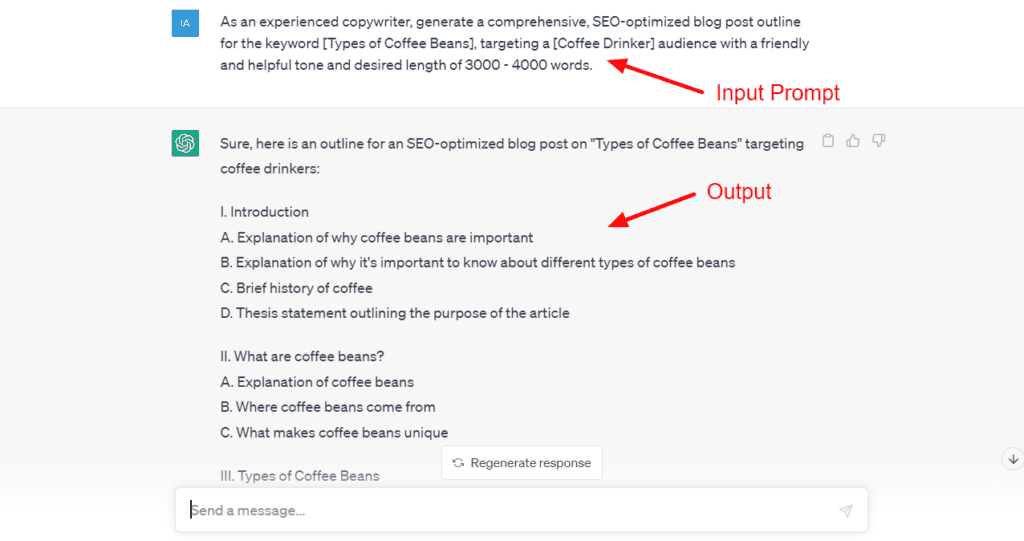
You can see how it crafted an in-depth outline for your article.
The important thing to note while framing your prompt is to assign ChatGPT an appropriate role, and mention the primary keyword, target audience, tone, and content length. This will help you generate focused results.
4. Rewrite Articles using ChatGPT
Another interesting use case of ChatGPT that I really appreciate is Article Rewriting! There are many situations where we need to align our content according to a specific keyword. This is where ChatGPT can help you.
All you need to do is paste the content you want to rewrite in the following prompt. You should also mention your target audience, keyword, and tone of voice to make the rewriting more efficient. Let’s understand it with an example.
Prompt: Rewrite [text] and use active voice and short sentences to make the content more readable for [target audience] in the context of [keyword].
Example: Rewrite“
Leather isn’t necessarily associated with comfort. Most leather chairs are designed to be very stylish and good-looking, but not exactly comfortable to sit in for hours at a time. That being said, many modern leather gaming chairs actually have several great features that help keep you comfortable for as long as possible.
One example is the thick padding that is built into the back and lumbar regions of leather chairs. It provides plenty of ergonomic support, which is very important for spending a long time seated in the same place.”
and use active voice and short sentences to make the content more readable for gamers in the context of “Mesh vs Leather Chair for Gaming”.

You can also optimize this rewritten content further by supplying it with the following prompt.
Prompt: Improve this [rewritten text] by adding a call-to-action (CTA) to encourage readers to take a specific action, such as signing up for a newsletter or purchasing a product.
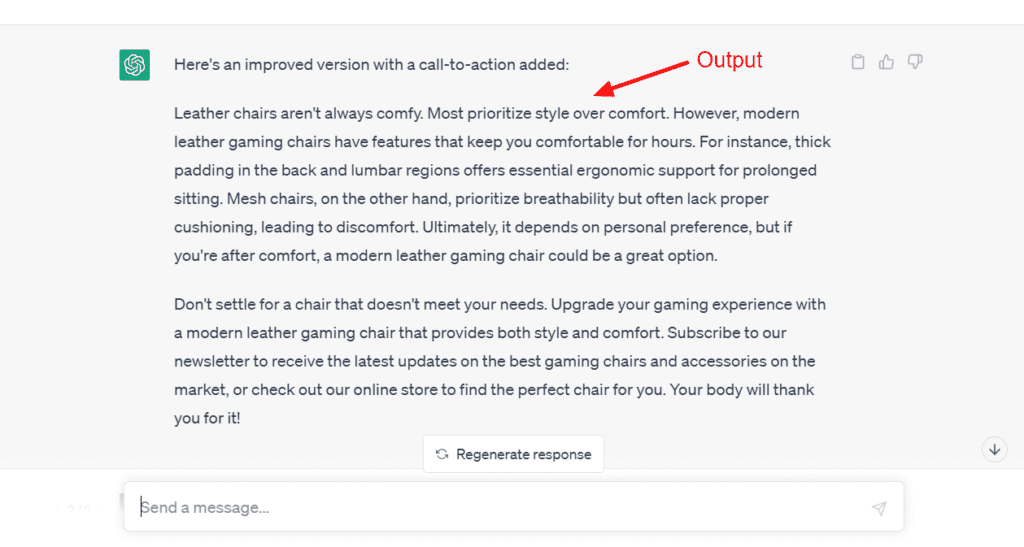
The finally rephrased content looks really precise and optimized for the keyword we supplied. This is mainly because of the additional instructions we provided in the prompt.
5. Creating SEO-Optimized Headlines
A well-written headline can increase your website traffic multifold! But this is what most of us struggle with. I use the following ChatGPT prompt to generate catchy headlines, keywords, and meta descriptions for my blogs.
Prompt:
Act as an SEO Copywriter.
I’ll provide an article outline & main keyword on several subjects.
You’ll have to provide 5-6 words long, catchy, click-worthy headlines that include the keyword and meta descriptions for them which also include the keyword.
For example, these are the results when I provided it the following outline along with the main keyword “AI Art Generator”
- Intro
- What is AI Art?
- How Does an AI Art Generator Work?
- Advantages of AI Art
- Understanding Text Prompts
- 4 Best Free AI Art Generators
- Step By Step Guide To Creating AI Art
- Tips for Creating Stunning AI Art
- Examples of AI-Generated Artwork
- Conclusion
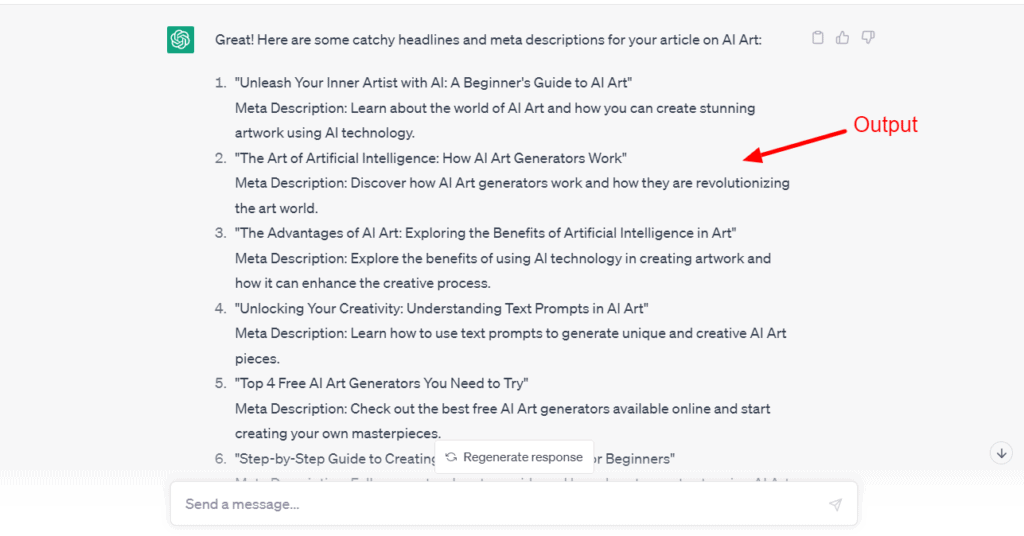
Most of the time, bloggers generate the titles first and then the blog outline, which may cause inconsistent outputs. My advice is to first generate the outline of your post and then go for the titles for more efficient and focused titles.
6. Using ChatGPT in Articles
AI-generated content may be vulnerable to penalties on search engine platforms. But I’ve found a super cool way to evade penalties.
You can use ChatGPT in two ways to make sure your content stands out and doesn’t get flagged as AI. Let’s check out how.
Analogies
Analogies simply draw comparisons between two different things. Including analogies in your blog posts can help you explain complex terms easily. Here’s how you can generate them.
Prompt: Give me an analogy for [enter a statement].
Example: Give me an analogy for “More than 50% of websites on the Internet are built on WordPress.”
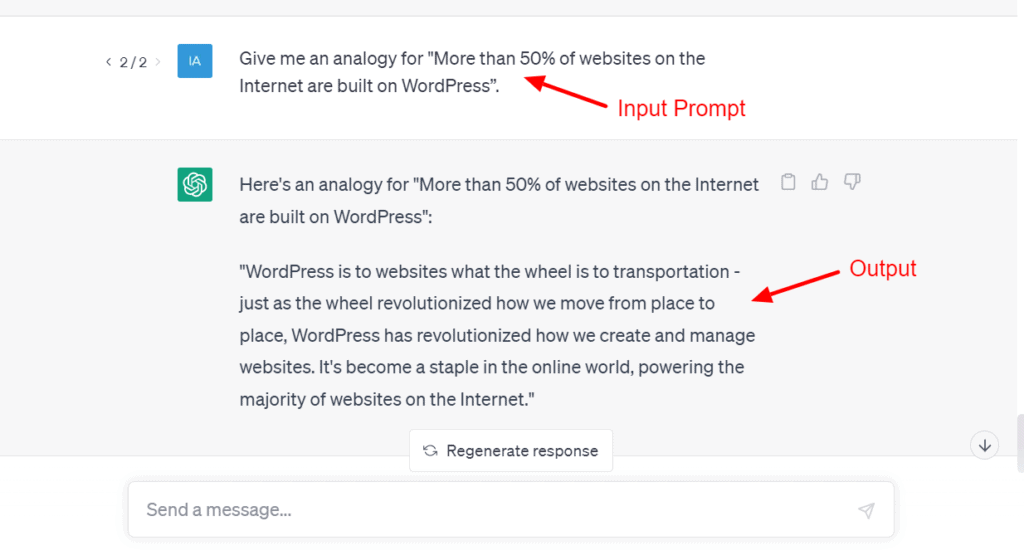
It will provide you with some unique and creative analogies for whatever topic you want! This is an excellent way to personalize your AI-generated blog posts.
Facts
Including facts and statistics in your blogs can improve your authority and ultimately boost your rankings. Here’s how you can get ChatGPT to generate facts for you.
Prompt: Generate a list of the top 10 facts, statistics, and trends related to [topic], including their source.
Example: Generate a list of the top 10 facts, statistics, and trends related to graphic design, including their source.
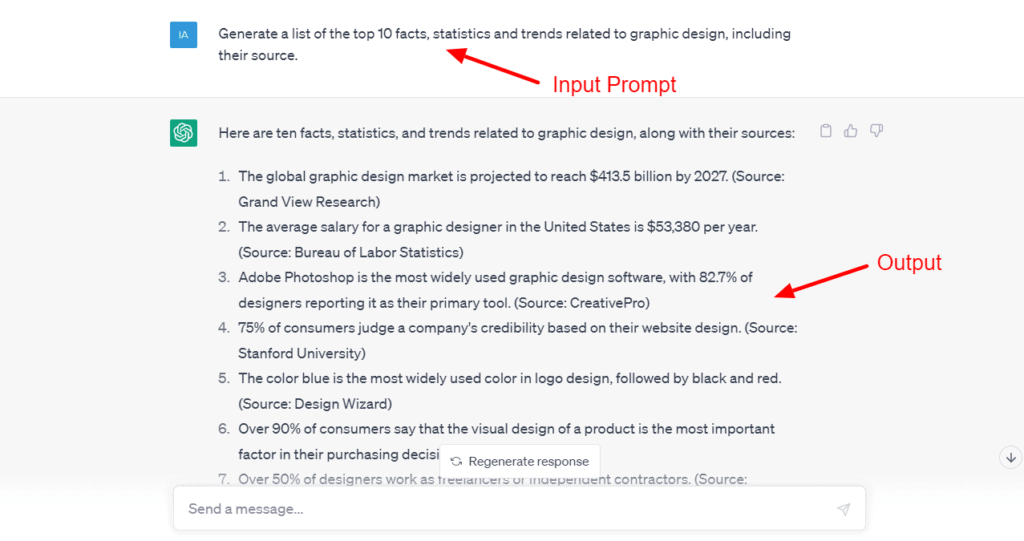
The best part about this prompt is that it also gives you the source of the facts and stats. Thus, you don’t need to go around searching the web for validating and referencing the information.
If you frequently generate your blog posts with AI writing tools, here is a list of the Best AI Content Detection Tools. You can cross-check your blogs with these tools to avoid publishing AI content.
7. Finding FAQs
I usually prefer different tools like Frase, MarketMuse, or NeuronWriter for finding FAQs. But if you don’t have access to any tools, you can also use ChatGPT to generate relevant FAQs for your posts. All you need to do is provide it the outline of your blog post.
Prompt: Generate a list of 10 frequently asked questions based on the following article outline: [Outline]
Example: Generate a list of 10 frequently asked questions based on the following article outline:
- Intro
- What is AI Writing?
- How Does an AI Writer Work?
- Why Should You Use AI Writers?
- Can AI Generated Content be Detected?
- Is AI-generated content unique?
- Does Google penalize AI-generated content?
- Tips to Use AI Writers Effectively
- Drawbacks of AI Writers
- Is AI Writing Free?
- Cost of Using AI Writers
- Can AI Writers Replace Humans?
- Conclusion
Here are the results generated.

This is how you can pick the most important questions from your article and answer them in the FAQs section.
Conclusion
This article revealed some interesting ways you can use ChatGPT to enhance your SEO practices. I hope you found these prompts and examples informative. Bloggers, SEO experts, and website owners will find the prompts discussed in this article quite useful.
If you’re a beginner in the world of blogging, here are some Free AI Content Generators that you can try out!
Anyway, how do you use ChatGPT for your blog posts? Have you used it for SEO content creation or other SEO tasks? Which of the above prompts was your favorite? Let me know in the comments box below.
This is Kripesh signing off. I’ll be back with more insightful articles soon. Till then, take care and keep learning. Cheers! 🙂


7 ChatGPT SEO Strategies
Thank you for providing this article I have benefited a lot from reading your article